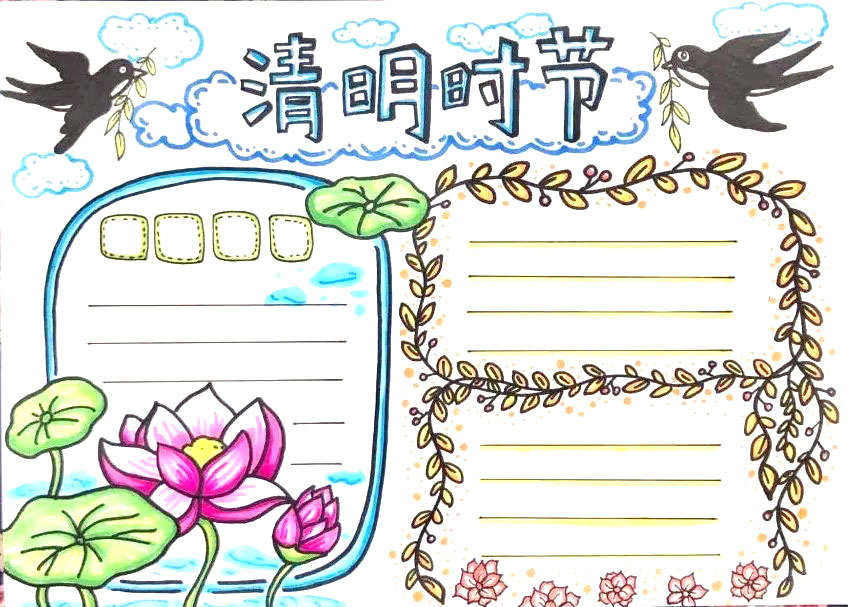清明节英文手抄报内容-清明节的习俗
归属:简笔画 时间: 05-25 来源:网络
清明节的习俗
清明节是一个特殊的日子,在这一天生者为他们死去的亲朋献上敬意。(Tomb-Sweeping Day falls on April 4th or 5th. This is a special day for the living to show their love and respect for dead friends and relatives.)每逢清明时节,中国人会去扫墓祭祖,在祖先坟前献上祭品、鲜花,烧些纸钱。有的人还会写悼文,缅怀逝去的亲人。
说到“纸钱”,英语中是怎么表述的呢?大家可能第一时间想到的就是paper money。不过字面上它是“纸钱”的意思,实际上paper money的意思是“纸质货币”,与metal money(金属货币)相对应,不是烧给死者的纸钱噢!那么,烧给死者的“纸钱”怎么表达呢?可以用joss paper或hell bank notes表示。
除了传统的祭祀方式,近年来,“绿色祭扫”逐渐成为人们扫墓的一种新趋势。不仅经济环保,还避免了烧纸钱等传统方式带来的火灾隐患。“绿色祭扫”的方式有很多,如网上祭扫(online tomb-sweeping)和网络纪念馆(Internet memorial)等。
扫墓 grave
At the Qingming Festival (Tomb-Sweeping Day), people usually worship their ancestors by burning incense and paper money at their ancestors' grave sites. People show respect to their ancestors by visiting their graves, and offering food, wine, flower, etc. They sweep the tombs, removing weeds, and adding fresh soil to the graves, stick willow branches on the tomb, and burn paper money. They pray before their ancestors' graves and beseech them to bless their families. However, the custom has been greatly simplified today, especially in cities, where only flowers are presented to the dead.
清明节,人们通常在祖宗坟前焚香烧纸,拜祭祖先。人们来到祖先坟前,供上食物、酒水、鲜花等,以示敬意。他们扫墓、除草、添土,在墓上插柳并焚烧纸钱。他们在祖先坟前祷告,请求他们保佑家人。但是,如今的习俗已大大简化,特别是在城里,他们只向逝者献花。
荡秋天 On the Swings
这是中国古代清明节习俗。秋千,意即揪着皮绳而迁移。它的历史很古老,最早叫千秋,后为了避忌讳,改之为秋千。古时的秋千多用树桠枝为架,再栓上彩带做成。后来逐步发展为用两根绳索加上踏板的秋千。荡秋千不仅可以增进健康,而且可以培养勇敢精神,至今为人们特别是儿童所喜爱。
This is the qingming festival custom in ancient China. Swing, ie, ripping up the leather rope and migration. Its history is very old, the first call and consent, in order to avoid taboo, after change it as a swing. Ancient tree swing multi-purpose YaZhi for frame, bolt ribbons made again. Then gradually developed to use two rope and a pedal swing. Swing can not only improve health, but also can cultivate the spirit of brave, for people, especially children's favorite.
荡秋千不仅可以增进健康,而且可以培养勇敢精神,至今为人们特别是儿童所喜爱。
Play not only improves the health swing, and can cultivate the brave spirit, tonow is people, especially children's favorite.
A ball is bowed, ball with leather skinmade, the ball inside with wool plugged. A game called cuju, which is withenough to play football. This is ancient tomb-sweeping day's favorite when a game.Legend has it that the invention of the yellow emperor, original purpose isused to train warrior.
鞠是一种皮球,球皮用皮革做成,球内用毛塞紧。蹴鞠,就是用足去踢球。这是古代清明节时人们喜爱的一种游戏。相传是黄帝发明的,最初目的是用来训练武士。
鞠是一种皮球,球皮用皮革做成,球内用毛塞紧。蹴鞠,就是用足去踢球。
A ball is bowed, ball with leather skinmade, the ball inside with wool plugged. A game called cuju, which is withenough to play football.
插柳 Insert willow
据说,插柳的风俗,也是为了纪念“教民稼穑”的农事祖师神农氏的。有的地方,人们把柳枝插在屋檐下,以预报天气。清明节谚有“柳条青,雨蒙蒙;柳条干,晴了天”的说法。黄巢起义时规定,以“清明为期,戴柳为号”。起义失败后,戴柳的习俗渐被淘汰,只有插柳盛行不衰。杨柳有强大的生命力,俗话说:“有心栽花花不发,无心插柳柳成荫。”柳条插土就活,插到哪里,活到哪里,年年插柳,处处成阴。
It is said that the work of the customs, is to commemorate the "leisure farm" of farming father of the emperor shen nung. In some places, people placed willow branches under the eaves, to predict the weather. Tomb-sweeping day is the "willow green, rain receive; the wicker dry, sunny days". Huang Chao uprising rules, to "for the tomb-sweeping day, Dai Liu to date". After a failed uprising, the custom of Dai Liu gradually be eliminated, only liu fixture. Willow has strong vitality, as the saying goes: "many hair, accidentally a remarkable." Wicker soil lived, where, where to live, year after year, colorful everywhere.
清明插柳戴柳还有一种说法:原来中国人以清明、七月半和十月朔为三大鬼节,是百鬼出没讨索之时。人们为防止鬼的侵扰迫害,而插柳戴柳。柳在人们的心目中有辟邪的功用。受佛教的影响,人们认为柳可以却鬼,而称之为“鬼怖木”,观世音以柳枝沾水济度众生。北魏贾思勰《齐民要术》里说:“取柳枝著户上,百鬼不入家。”清明既是鬼节,值此柳条发芽时节,人们自然纷纷插柳戴柳以辟邪了。
Qingming festival work Dai Liu has a saying: the original Chinese to the tomb-sweeping day, half July and October back to three Halloween, beg suo is haunted by a ghost. People in order to prevent the intrusion of ghost persecuted, and willow Dai Liu. Willow has the function of to ward off bad luck in people's mind. Influenced by Buddhism, willow were thought to ghost, and call it "ghost some wood", the goddess of mercy to switch touch water to degrees of living beings. In the northern wei jia sixie qimin yaoshu said: "take willow branches on the door, a ghost does not enter the house." On the occasion of the willow germination time, the tomb-sweeping day is Halloween, people naturally have inserted liu Dai Liu to ward off bad luck.
蚕花会 Silkworm flower show
“蚕花会”是蚕乡一种特有的民俗文化,过去清明节期间,梧桐、乌镇、崇福、洲泉等地都有此项民俗活动。其中以洲泉的马鸣庙和青石的双庙诸的蚕花会最为精彩隆重。马鸣庙位于洲泉镇西,在当地有“庙中之王”之称,每年蚕花会人山人海,活动频繁,有迎蚕神、摇快船、闹台阁、拜香凳、打拳、龙灯、翘高竿、唱戏文等十多项活动。这些活动有的在岸上进行,绝大多数在船上进行,极具水乡特色。近几年乌镇香市活动中的蚕花会,仅有迎蚕神、踏白船、翘高竿等几个项目,大有潜力可挖。
Silkworm flower show "silkworm flower show" is a kind of unique folk culture of silkworm township, in the past during the qingming festival, wutong springs, wuzhen, chung fu, state and other places have the folk activities. In which continent springs Ma Ming temple and bluestone ShuangMiao the silkworm flower is the most wonderful grand. Springs west Ma Ming temple is located in the state, in the local has the "king of the house," said, silkworm flower people mountain people sea, every year, one to meet silkworm god, shaking the clippers, eventually leaves, worship the stool, boxing, dragon lantern, become warped high pole, singing opera and so on more than ten activities. Some of these activities on shore, the vast majority of on board ship, water features extremely. Silkworm flower wuzhen incense city activities in recent years, only to meet silkworm god, stepping white ship, become warped a few projects such as the high pole, great potential.
牵钩 Pull hook
牵钩”是古称,其实就是现代的拔河运动。据说春秋时,楚国为了进攻吴国,以牵钩这种运动来增强人民的体质。它主要是以一根麻绳,两头分为许多小绳,比赛时,以一面大旗为界,一声令下,双方各自用力拉绳,鼓乐齐鸣,双方助威吶喊,热闹非常。
"Pull hook" is called, in fact, the modern tug-of-war sport. It is said that in the spring and autumn, in order to attack chu wu to hook the movement to improve people's physical fitness. It is primarily a rope, two head is divided into many small line, game, with a banner for the world, commanded, each pull rope, the music is, everywhere cheer both sides up, a lively group.

清明节英文手抄报内容-清明节的习俗-图1